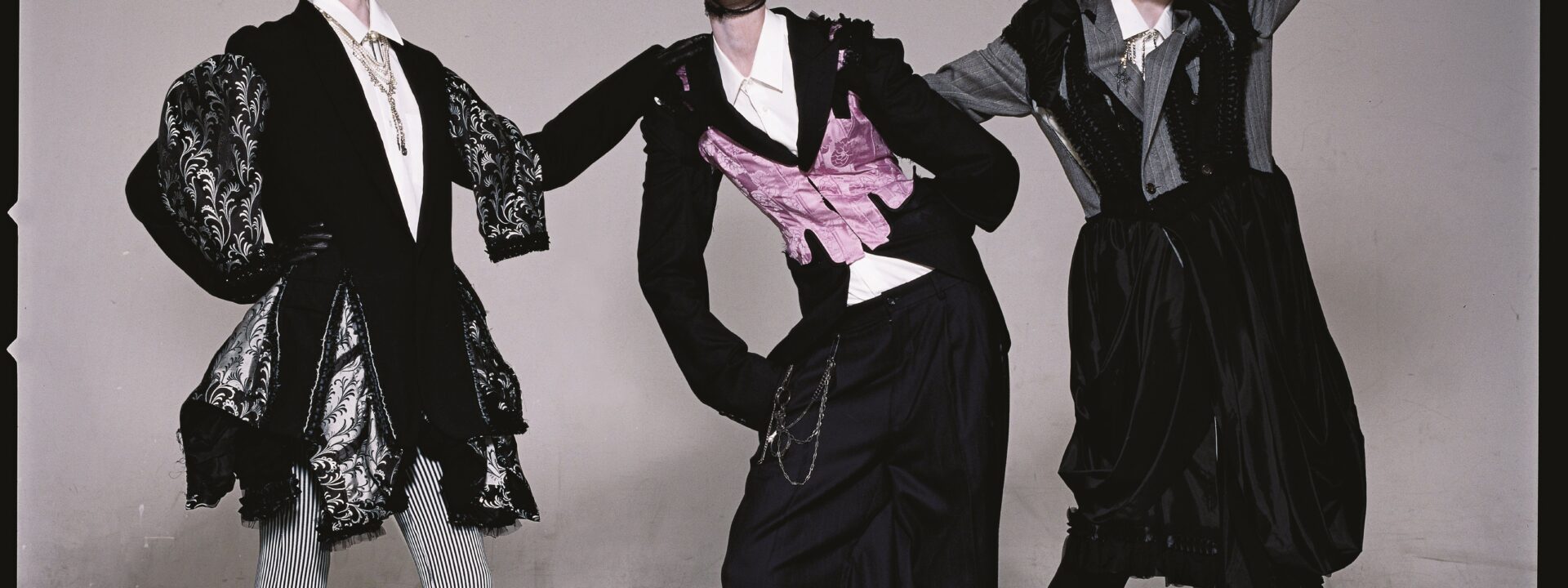“What you see on the surface isn’t always what lies beneath,” remarked Rei Kawakubo about her fall 2006 collection, modeled here by Lisa Cant, Sasha Pivovarova, and Gemma Ward (from left). The photograph was taken by Irving Penn for Vogue in September 2006.
A century ago today, Universal Pictures released The Phantom of the Opera, a silent film based on Gaston Leroux’s 1910 Gothic novel. A journalist at the time summarized the plot: “It tells of a mysterious being of the shadows, blessed with divine talents but cursed with a monstrous face, whose twisted soul chooses a young opera singer to settle a score he feels the world owes him.” He was a tormented soul with maternal wounds, concealing a face his mother rejected behind a mask. In exchange for bestowing a golden voice upon a soprano, he demanded her love.
Lon Chaney, who portrayed the Phantom Erik, designed his own skeletal makeup for the role.
This story has been reinterpreted across various platforms—stage, screen, and even fashion. For me, the title always brings to mind Rei Kawakubo’s fall 2006 Comme des Garçons collection. The show was held beneath the grand chandeliers of the Sorbonne, set to Verdi’s aria “La Donna è Mobile” (“Woman Is Fickle”). Fickleness is a label often attached to the fashion world, but Kawakubo embraces change, using it strategically to challenge the establishment. In this collection, the battle of the sexes unfolded not in an opera house but within individual garments, where masculine and feminine elements clashed rather than harmonized.
The Sorbonne, illuminated by sparkling chandeliers, provided the backdrop for the show.
One of Kawakubo’s key themes that season, as noted by Sarah Mower, was the concept of persona—the contrast between outward appearance and inner reality, or self-presentation. Mower described the collection as “a powerful exploration of masculinity and femininity, and the daily drama of dressing.” Kawakubo deconstructed and reimagined combinations of his and hers: a corset integrated into a pantsuit jacket, dresses layered over jackets, fabric revealed through slits, and trains attached to pants that presented a masculine front and a feminine back. Some pieces had a Shakespearean flair (like Look 10) or a hint of flamenco. It was all about drama, she said.
Each look featured masculine-style shoes and elaborate headpieces by Kawakubo’s frequent collaborator, Julien d’Ys. Fedoras were paired with masks tied around the head, nets covered faces up to the mouth, and berets were cut open. Some hats were adorned with flowers, others with spirals of pleated ribbons. The most phantom-like were the half masks, some with surreal profiles, all emphasizing the eyes.
Lon Chaney appeared in the 1925 film The Phantom of the Opera, while masks by Julien d’Ys for Comme des Garçons echoed the Phantom’s mystique in the 2006 collection. Claude Rains and Gerard Butler also played the Phantom in later film adaptations.
In “Fight Club,” a story about…In the September 2006 issue of Vogue, which featured Japanese designers challenging the status quo, Comme des Garçons designer Rei Kawakubo shared with Mower: “From the start, it wasn’t just about creating clothing. I aimed to build a company that mirrored my inner values, as I sought independence and freedom from financial backers.”
Kawakubo encourages us to perceive and engage with the world in unconventional ways. In a field often preoccupied with appearances, she crafts beautiful yet restless garments. Their unique structure stems from her deep introspection, resulting in pieces that seem to embody their own emotions and convictions, giving them an eerily beautiful quality. This season, her theme was clear: masks may alter your appearance, but they cannot change your true self.
Comme des Garçons, fall 2006 ready-to-wear collection.
Frequently Asked Questions
Of course Here is a list of FAQs about the iconic Fall 2006 Comme des Garons collection often referred to as the Lilith or Balloon collection
General Beginner Questions
Q What was so special about the Fall 2006 Comme des Garons collection
A It was a groundbreaking show where Rei Kawakubo challenged the traditional silhouette of clothing The models wore huge distorted and inflated shapes that completely obscured the body turning fashion into wearable art
Q What is the official name of this collection
A The official name is Comme des Garons ReadytoWear FallWinter 2006 Its often nicknamed the Lilith or Balloon collection by fans and critics
Q Who designed it
A It was designed by Rei Kawakubo the legendary founder and chief designer of Comme des Garons
Q Why do people still talk about it today
A Its considered a pivotal moment in 21stcentury fashion It wasnt about being pretty or flattering it was a radical artistic statement about form volume and the purpose of clothing which continues to inspire designers and artists
The Design Concept
Q What was the main inspiration or concept behind the collection
A Rei Kawakubo stated the theme was not a garment She was exploring the space between the body and the clothing itself creating abstract sculptural forms
Q What were the key design elements
A The key elements were extreme volume padded and inflated shapes asymmetry and a monochromatic color palette The human form was almost completely hidden
Q Were the clothes actually wearable in everyday life
A For the most part no The runway pieces were extreme artistic expressions However the ideas and concepts from this collection trickled down into more wearable but still avantgarde pieces sold in Comme des Garons stores
Q What materials were used to create those big shapes
A The inflated balloonlike forms were often created using padding quilting and lightweight synthetic materials stuffed with down or synthetic fill structured over internal armatures
Impact Legacy
Q How was the collection received by critics at the time
A It received polarized reactions


